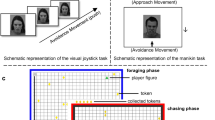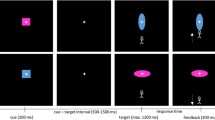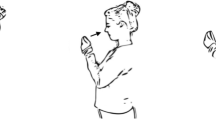Abstract
Participants displaying high versus low levels of experiential avoidance as assessed by the Acceptance and Action Questionnaire (Hayes, Strosahl, et al., 2004) were compared in their reactions to and performance on a challenging perceptual-motor task. Participants were offered incentives for sorting colored straws into different colored containers as quickly as possible during the simultaneous induction of unpleasant sensations (dizziness, blurred vision, disorientation) by the wearing of “drunk goggles” during task performance. High avoidant participants reported being more likely to engage in catastrophizing and to be distressed by sensations induced during the task, despite, as expected, apparently minimizing contact with such experiences by sorting significantly fewer straws than their low avoidant counterparts. The findings are related to similar research consistent with the conceptualization of experiential avoidance as a functional response class supporting diverse forms of dysfunctional behavior and human suffering.
Similar content being viewed by others
References
AMERICAN PSYCHOLOGICAL ASSOCIATION. (2002). Ethical principles of psychologists and code of conduct. American Psychologist, 57, 1060–1073.
BERNSTEIN, E., & PUTNAM, F. (1986). Development, reliability, and validity of a dissociation scale. Journal of Nervous and Mental Disease, 174, 727–735.
COHEN, J. (1977). Statistical power analysis for the behavioral sciences (rev. ed.). New York: Academic Press.
DAHL, J., WILSON, K. G., & NILSSON, A. (2004). Acceptance and commitment therapy and the treatment of persons at risk for long-term disability resulting from stress and pain symptoms: A preliminary randomized trial. Behavior Therapy, 35, 785–801.
FELDNER, M. T., ZVOLENSKY, M. J., EIFERT, G. H., & SPIRA, A. P. (2003). Emotional avoidance: An experimental test of individual differences and response suppression using biological challenge. Behaviour Research and Therapy, 41, 403–411.
GEISSER, M. E., ROBINSON, M. E., & PICKREN, W. E. (1992). Differences in cognitive coping strategies among pain-sensitive and pain-tolerant individuals on the cold-pressor test. Behavior Therapy, 23, 31–41.
GUTIERREZ, O., LUCIANO, C., RODRIGUEZ, M., & FINK, B. C. (2004). Comparison between an acceptance-based and a cognitive-control-based protocol for coping with pain. Behavior Therapy, 35, 767–783.
HAAGA, D. A. F. (Ed.). (2004). Research on acceptance and commitment therapy [Special issue]. Behavior Therapy, 35(4).
HAYES, S. C. (2004). Acceptance and commitment therapy, relational frame theory, and the third wave of behavioral and cognitive therapies. Behavior Therapy, 35, 639–665.
HAYES, S. C., BARNES-HOLMES, D., & ROCHE, B. (2001). Relational frame theory: A post-Skinnerian account of language and cognition. New York: Plenum.
HAYES, S. C., MASUDA, A., BISSETT, R. T., LUOMA, J., & GUERRERO, L. F. (2004). DBT, FAP, and ACT: How empirically oriented are the new behavior therapy technologies? Behavior Therapy, 33, 35–54.
HAYES, S. C., & STROSAHL, K. (Eds.). (2004). A practical guide to acceptance and commitment therapy. New York: Springer.
HAYES, S. C., STROSAHL, K., & WILSON, K. G. (1999). Acceptance and commitment therapy: An experiential approach to behavior change. New York: Guilford.
HAYES, S. C., STROSAHL, K., WILSON, K. G., BISSETT, R. T., PISTORELLO, J., TOMARINO, D., et al. (2004). Measuring experiential avoidance: A preliminary test of a working model. The Psychological Record, 54, 553–578.
HAYES, S. C., WILSON, K. G., GIFFORD, E. V., FOLLETIE, V. M., & STROSAHL, K. (1996). Experiential avoidance and behavioral disorders: A functional dimensional approach to diagnosis and treatment. Journal of Consulting and Clinical Psychology, 64, 1152–1168.
HINES, E. A., & BROWN, G. E. (1932). A standard stimulus for measuring vasomotor reactions: Its application to the study of hypertension. Proceedings of the Staff Meetings of the Mayo Clinic, 7, 332
KAREKLA, M., FORSYTH, J. P., & KELLY, M. M. (2004). Emotional avoidance and panicogenic responding to a biological challenge procedure. Behavior Therapy, 35, 725–746.
KEEFE, F. J., CRISSON, J. E., URBAN, B. J., & WILLIAMS, D. A. (1990). Analyzing chronic low back pain: The relative contribution of pain coping strategies. Pain, 40, 293–301.
KINDSCHUH, C. S. (2001). U.S. Patent No. 6,206,521. Washington, DC: U.S. Patent and Trademark Office.
LEVITT, J. T., BROWN, T. A., ORSILLO, S. M., & BARLOW, D. H. (2004). The effects of acceptance versus suppression of emotion on subjective and psychophysiological response to carbon dioxide challenge in patients with panic disorder. Behavior Therapy, 35, 747–766.
LINEHAN, M. M. (1993). Cognitive-behavioral treatment of borderline personality disorder. New York: Guilford.
MCCRACKEN, L. M., & ECCLESTON, C. (2003). Coping or acceptance: What to do about chronic pain? Pain, 105, 197–204.
SEGAL, Z. V., WILLIAMS, J. M. G., & TEASDALE, J. D. (2002). Mindfulnessbased cognitive therapy for depression: A new approach to preventing relapse. New York: Guilford.
SIEGEL, S. (1956). Nonparametric statistics for the behavioral sciences. New York: McGraw-Hill.
WEGNER, D. M., & ZANAKOS, S. (1994). Chronic thought suppression. Journal of Personality, 62, 615–640.
WHEELER, J. G., CHRISTENSEN, A., & JACOBSON, N. S. (2001). Couple distress. In D. H. Barlow (Ed.), Clinical handbook of psychological disorders: A step-by-step treatment manual (3rd ed., pp. 609–630). New York: Guilford.
ZETILE, R. D., & HAYES, S. C. (2002). Brief Act treatment of depression. In F. W. Bond & W. Dryden (Eds.), Handbook of brief cognitive behaviour therapy (pp. 35–54). West Sussex, England: Wiley.
ZETILE, R. D., HOCKER, T. R., MICK, K. A., SCOFIELD, B. E., PETERSEN, C. L., SONG, H., & SUDARIJANTO, R. P. (2005). Differential strategies in coping with pain as a function of level of experiential avoidance. The Psychological Record, 55, 511–524.
Author information
Authors and Affiliations
Corresponding author
Rights and permissions
About this article
Cite this article
Zettle, R.D., Petersen, C.L., Hocker, T.R. et al. Responding to a Challenging Perceptual-Motor Task as a Function of Level of Experiential Avoidance. Psychol Rec 57, 49–62 (2007). https://doi.org/10.1007/BF03395564
Published:
Issue Date:
DOI: https://doi.org/10.1007/BF03395564




